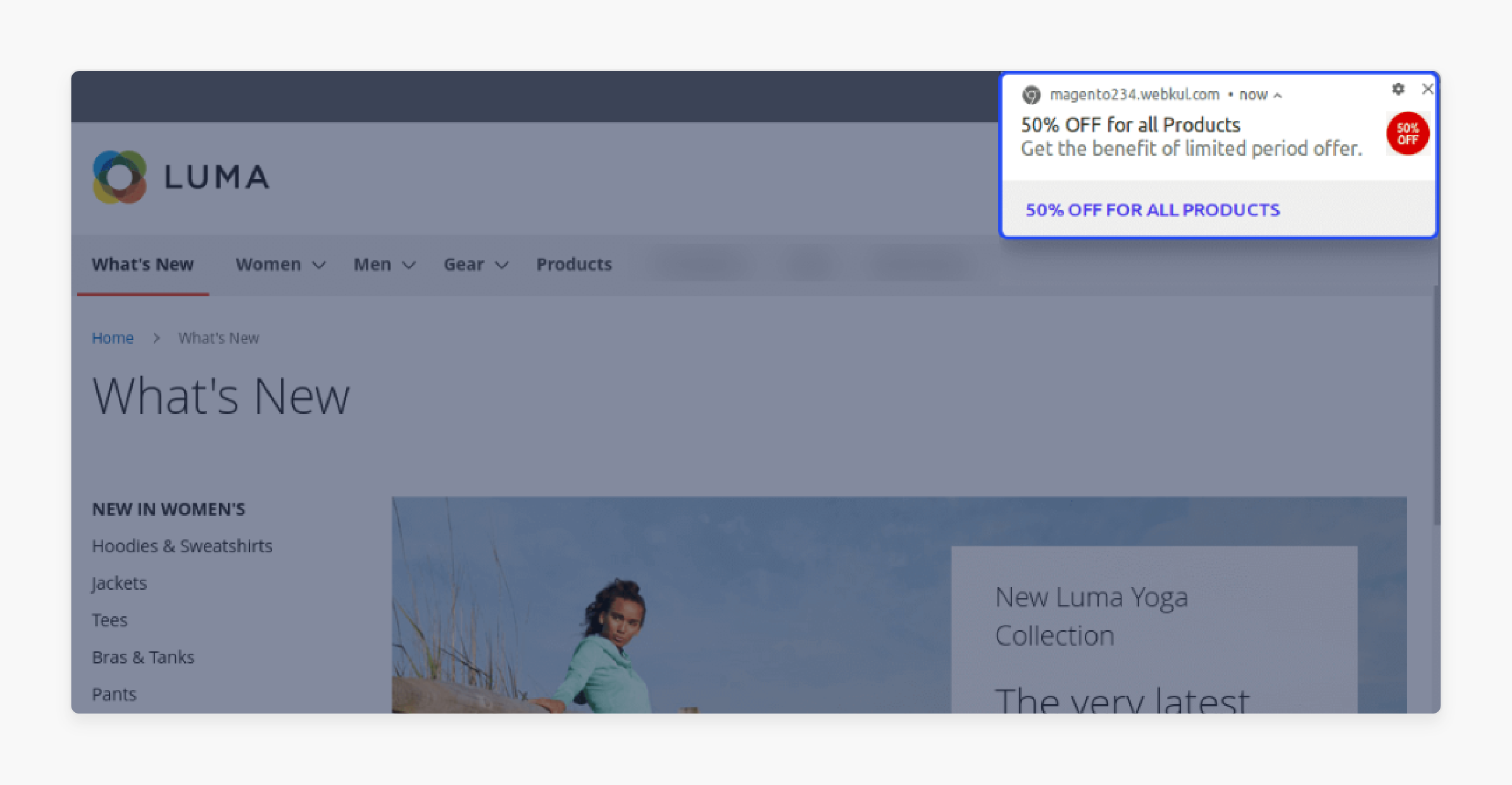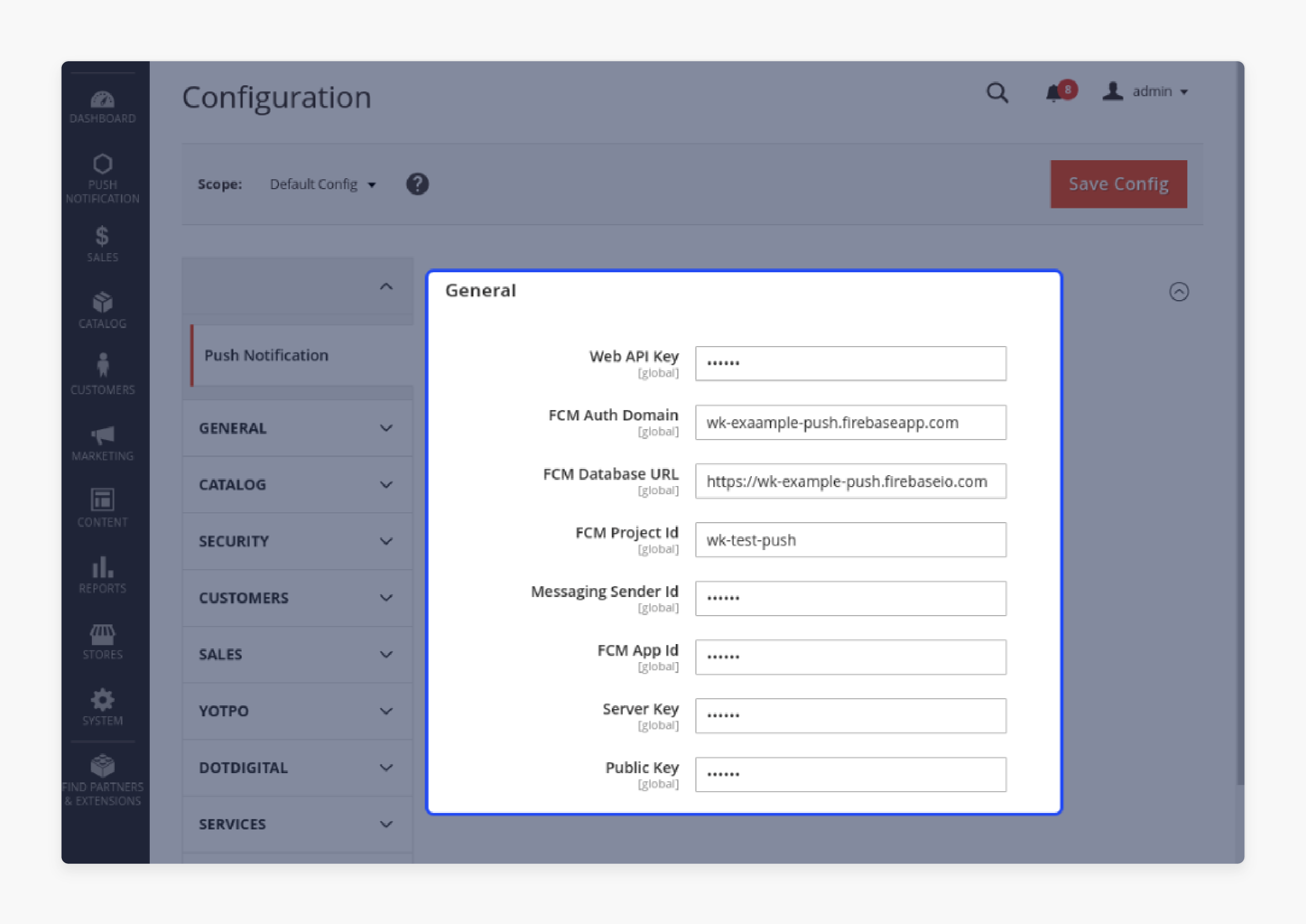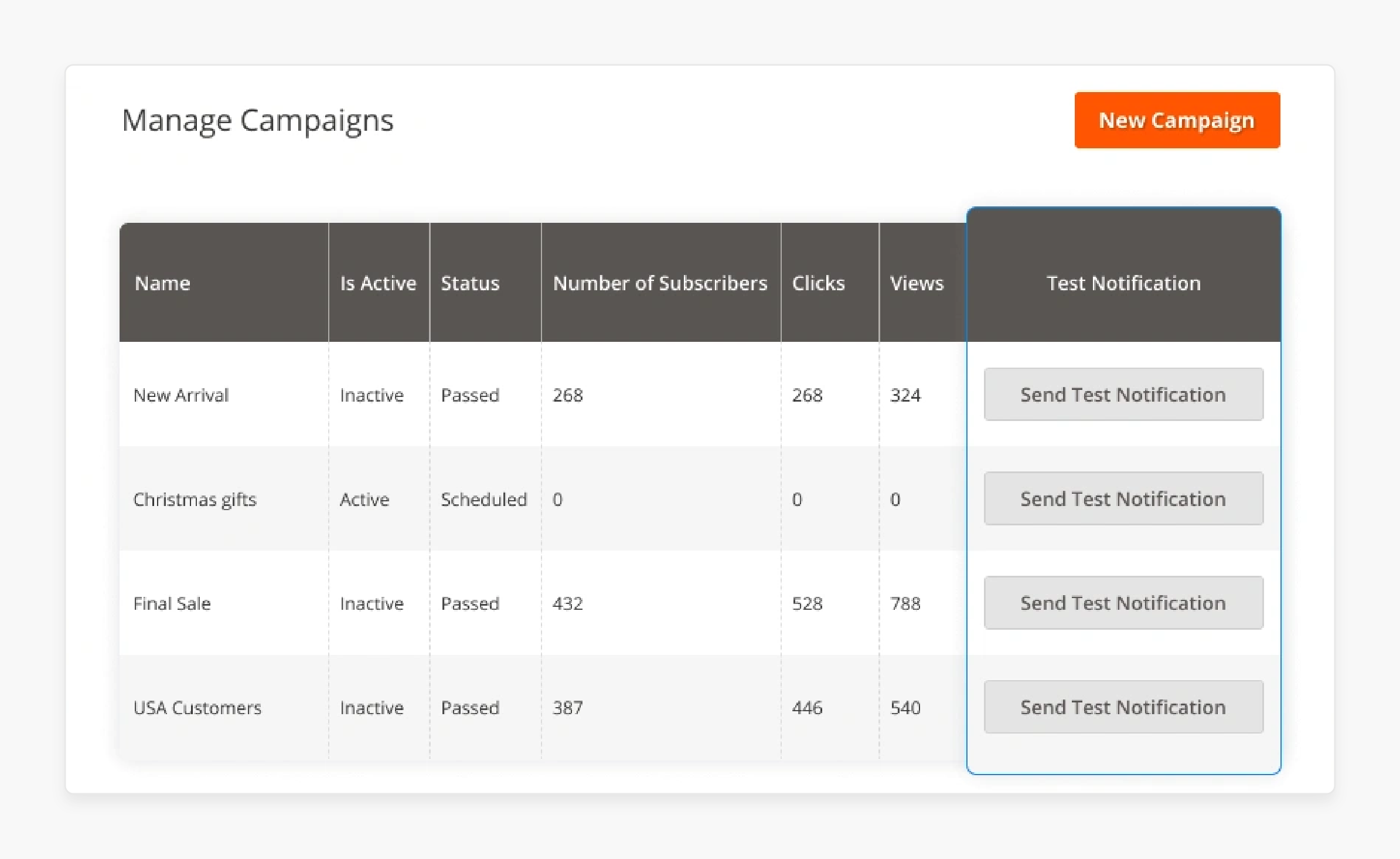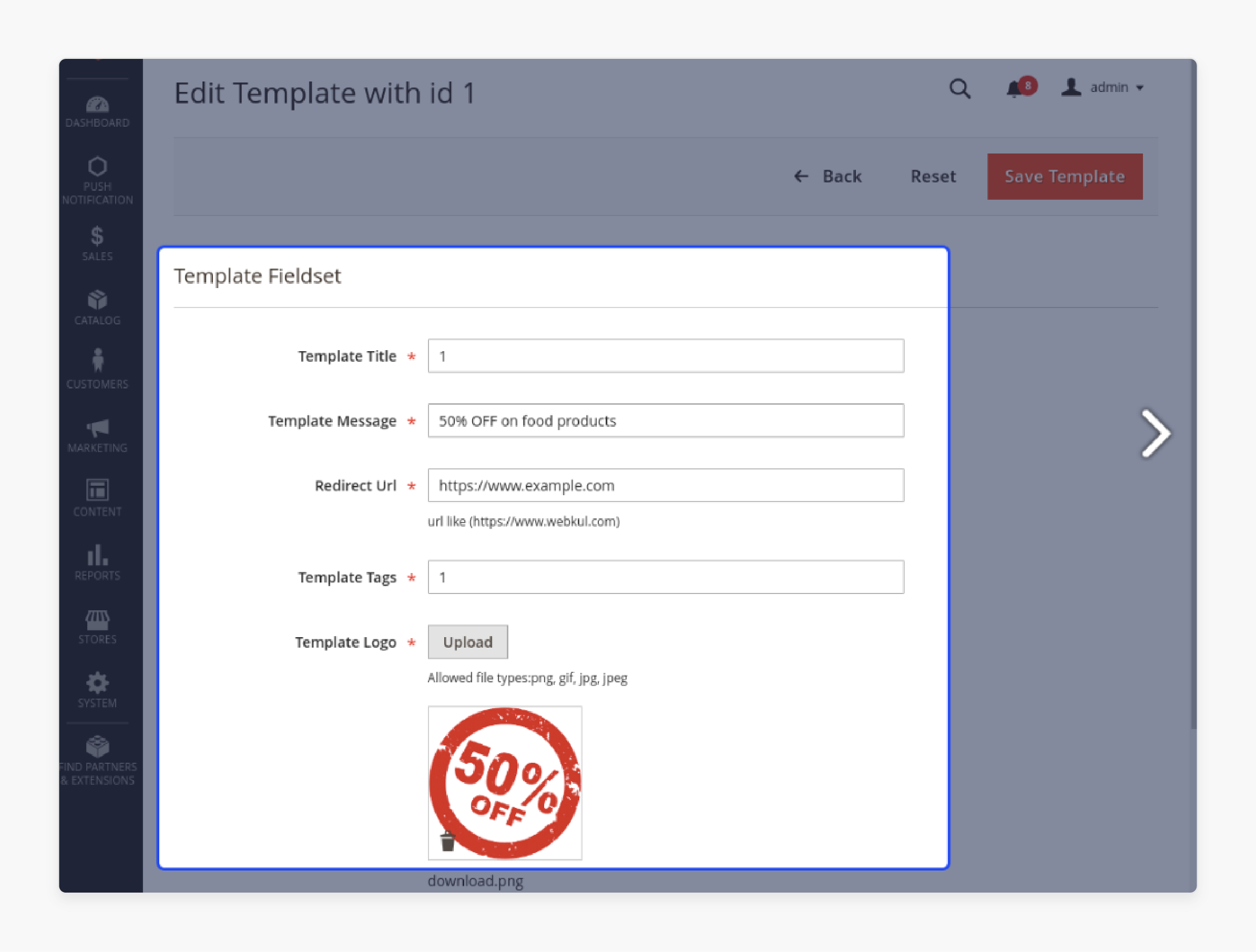
Push Notification Magento 2: Prerequisites and Configuration
Are your abandoned cart emails going unread? Push Notification Magento 2 helps you reach customers even when they are not on your website.
The article explores the prerequisites, working, and configuration of push notifications.
Key Takeaways
-
Push notifications send real-time messages to users' browsers even when they're offline.
-
HTTPS and service workers are essential technical requirements for implementation.
-
Third-party extensions, such as OneSignal, enable push notification functionality.
-
Segmentation enhances engagement rates and the recovery of abandoned carts.
-
Brands like H&M achieved 2- 3x conversion increases using push notifications.
What Are Push Notifications?

Push notifications are real time messages sent to users' browsers or mobile devices. It doesn’t need active browsing.
These notifications help re-engage users by providing updates about:
-
Promotions
-
Abandoned carts
-
Order statuses
-
Restocked items
Magento 2 does not support push notifications. You can add them using third-party extensions, such as OneSignal. You can also add them through Progressive Web Apps.
Users must opt in to receive notifications. Then, the store can send personalized and timely alerts. It helps drive traffic and increase conversions.
These messages are effective marketing tools to keep customers informed. It also enables repeat visits to your store. It makes them a valuable feature for improving user engagement and sales in Magento 2.
8 Prerequisites for Implementing Push Notifications
1. HTTPS (SSL Certificate)
-
Push notifications need a secure HTTPS connection for your website to function.
-
Modern browsers like Chrome and Firefox block push notifications on non-secure (HTTP) sites. It is for security and privacy reasons.
-
Buy and install an SSL certificate on your server. Ensure your entire Magento store redirects to HTTPS. It uses Magento admin settings or .htaccess rules. Test the SSL using tools like SSL Labs.
2. User Opt-In Mechanism
-
Your site must be able to request permission from users to send push notifications.
-
You need a mechanism, usually part of the push service or extension. It displays a browser-level opt-in prompt.
-
Ensure your system tracks whether the user has allowed or denied this request. Handles re-permission requests if the user blocks it. Push service or extension you are using handles it.
3. Functional Magento 2 Store

-
You must have a functional Magento 2 store as the base platform.
-
Ensure your store:
1. It is installed and operational
2. Has access to the admin panel for configuration
3. Is running a stable, updated version of Magento 2
-
Verify that your Magento theme is compatible with the chosen push extension.
4. Push Notification Extension or Integration
-
Magento does not include built-in support for push notifications. You must use a third-party extension or integrate with a push service provider like:
1. OneSignal
2. PushEngage
3. WebPush
4. Firebase Cloud Messaging (FCM) via custom development or PWA
5. Many developers offer ready-to-use push Magento extensions on the Magento Marketplace.
-
These tools help you send and manage notifications. The features to consider include:
1. Scheduled messages
2. Segmentation
3. Analytics and performance tracking
4. Abandoned cart reminders
5. Welcome or onboarding notifications
5. Service Worker File (JavaScript Worker)
-
A service worker is a JavaScript file that runs in the background of a web page. It receives and displays incoming push notifications. It doesn’t need active browsing of the site.
-
Your Magento theme or custom module must include and register this script. It:
1. Listens for push messages from the server
2. Displays them as notifications
3. Handles click actions or other user interactions
-
The file resides in the root of your Magento installation. Your website's frontend code must register it.
6. API Keys and Service Configuration
-
Push notification services need configuration using API keys or credentials. Most push services need you to:
1. Create an account with your selected push provider
2. Create a new project or app within their dashboard
3. Generate API key or Web Push ID
4. Enter these credentials into your Magento admin or extension settings
-
It connects your store to the push service, allowing you to send messages. Always store API credentials and never expose private keys on the front end.
7. Progressive Web App (PWA) Integration
-
If you are using or planning to use a PWA frontend, push notifications are easier to use. These fronts include Magento PWA Studio or ScandiPWA.
-
PWAs are ideal for mobile-first stores. It provides better support for background services, such as push.
-
These include service worker support by default. It offers better background sync capabilities and improved mobile user experience.
-
Magento PWA Studio is Magento's official PWA framework. It supports push notifications with proper customization.
8. Browser Compatibility and Testing Tools
Before going live, you will need to ensure:
-
Notifications are compatible with major browsers, including Chrome and Safari. You have tested it on both desktop and mobile devices.
-
Permissions and fallback behavior are working.
How Push Notifications Work in Magento 2?
1. User Visits the Store and Opts In
-
The Magento store shows a browser permission prompt to users visiting. It asks them if they want to receive notifications.
-
If they accept, their browser creates a unique subscription token. It is then stored in the browser’s memory.
2. Service Worker Registration
-
The push extension or PWA adds a service worker to the website. It is a background JavaScript file.
-
This service worker runs in the background, even when the website is not working. It listens to the push messages.
3. Stores User Subscription
-
The push notification service provider receives the subscription information. The information includes the user’s browser and device data. These providers are:
1. OneSignal
2. Firebase
3. PushEngage
-
Magento stores this information via the extension to segment and target users.
4. Sending Notifications from Admin or Automatic

-
Notifications can be:
1. Manual trigger, including a promotional campaign
2. Automatic trigger, including abandoned cart reminders or order updates
-
The Magento admin or external service dashboard composes and sends notifications.
5. Delivers Push Notification
-
The push service provider sends the message to the user's device. It uses the subscription token.
-
The browser receives and displays the message on the user's screen. It doesn’t need active browsing of your site.
6. User Interacts with Notification
-
The user can click and redirect the notification to a specific page, such as:
1. Cart page
2. Offer page
3. Product detail
-
The service worker handles this click event, bringing the user back into the store.
7 Advanced Configuration and Integration
1. Integration with Third-Party Services
-
Magento 2 doesn’t provide built-in support. Advanced features rely on push notification platforms like:
1. OneSignal
2. Firebase Cloud Messaging (FCM)
3. WebPushr
4. PushEngage
-
Install the official or third-party Magento extension. Connect the extension to the push platform via API keys and App IDs.
-
Configure service worker registration and initialize the SDK/scripts on the front end.
-
Most services provide ready-to-use Magento plugins or JavaScript SDKs. You can embed them in your site header or footer.
2. User Segmentation and Targeting
-
Advanced services allow segmenting your audience based on:
1. Location
2. Device type
3. Buy history
4. Browsing behavior
5. Cart status
-
Send discount alerts only to users who abandoned their carts within 24 hours. Segmentation boosts click-through rates and reduces notification fatigue.
3. Automated and Triggered Campaigns
-
You can create dynamic push notification workflows based on customer behavior. These triggered notifications include:
1. Cart abandonment
2. Product price drop
3. Back in stock
4. Order updates
-
The scheduled campaigns include:
1. Daily deals
2. Time-based promotions
3. Birthday or loyalty rewards
-
Most services include a visual automation builder or cron jobs. It allows you to trigger events based on Magento data.
4. Personalized Notifications with Dynamic Content

-
Use dynamic tags to personalize messages based on user data:
1. {{user.name}} show the customer’s first name
2. {{product.name}} include product names from their cart or wishlist
3. {{discount.code}} insert personal coupon codes
-
More engaging and relevant messages lead to higher conversions.
5. Custom Service Worker Enhancements
-
You can customize your service worker script to:
1. Handle click events, such as direct users to a specific landing page.
2. Add rich media, including icons and vibration patterns
3. Queue messages or retry on failure
4. Handle silent notifications for background updates
-
It requires knowledge of JavaScript but provides full control over the notification behavior.
6. Analytics and A/B Testing
-
Many platforms support:
1. Real-time metrics such as delivered or clicked
2. Conversion tracking of who clicked and completed the buy
3. A/B testing to compare message formats or CTAs
-
Run tests with different headlines and notification timing. It helps identify what performs best with your audience.
7. Magento Events and Custom Triggers
-
Use observers or plugins to fire custom push notifications. It lets you hook into Magento events like:
1. On sales_order_place_after, notify users of their new order.
2. On customer_register_success, send a welcome discount.
3. On wishlist_add_product, send reminders about wishlist items.
-
You can write custom observers in your module to send data to your push provider via their API.
5 Innovative Use Cases for Magento 2 Push Notifications
| Brand | Use Cases | Result |
|---|---|---|
| 1. ASOS | Use time-sensitive nudges to recover carts by showing urgency. Use extensions like PushAssist to trigger automated cart abandonment reminders. Integrate a countdown timer in the push. Magento plugins, such as Mageplaza Abandoned Cart, can also be paired with push tools. Personalize with product images and dynamic variables, such as {customer_name} or {product_name}. | ASOS achieves a cart recovery rate of up to 25% and higher checkout completion rates with timely nudges. |
| 2. H&M | Drives massive traffic with quick alerts on drops and sales. Use Magento Scheduled Promotions + push tools like PWA Studio. Schedule push campaigns in advance for sales events, new launches, or restocks. Use segmentation to target VIPs first for early access. | H&M’s push campaigns often create sell-outs in hours. They also see a 2x-3x spike in conversions. |
| 3. Amazon | Sends super-personalized suggestions based on AI behavior modeling. Use AI-driven engines like Adobe Sensei or Klevu. Integrate with a push provider that supports custom events and triggers. | Amazon drives massive ROI via personalization. There is a 28–35% boost in CTR and repeat visits. |
| 4. Zalando | Combine push notification tools with Magento 2 order status events. Use Firebase or WebPushr to send updates at every stage. These include the period from the order placed to delivery. Add review requests post-delivery. | Zalando keeps customers engaged through the delivery journey. There is a 40–60% increase in open rate on shipping and delivery updates. |
| 5. Urban Outfitters | Notify users when saved items drop in price. Use wishlist or stock alert extensions, such as Amasty Stock Alert. Trigger a web push notification when the price drops or a product restocks. | Urban Outfitters experiences a 20–30% increase in conversion rates through timely restock alerts. |
FAQs
1. Can you schedule Magento 2 push notifications?
Most Magento 2 push notification extensions include scheduling capabilities. It allows you to plan notifications for specific dates and times. It also helps trigger them based on customer actions.
2. Do push notifications work when the website is not working?
Once users have opted in, they will receive notifications. They will receive them even when your website isn't open in their browser. It makes push notifications especially valuable for re-engagement.
3. How can I personalize push notification templates?
Modern Magento 2 push notification extensions support dynamic content using customer data variables. It allows you to insert customer names and other personalized elements.
4. Can you use push notifications for abandoned cart reminders?
It is one of the most effective uses of push notifications. Recovery rates often exceed those of email campaigns. This is due to the immediate visibility of notifications.
Summary
Push notifications enhance engagement and facilitate timely updates, such as promotions or order statuses. The article explores the key features of the notifications, including:
-
HTTPS, user opt-in, and a service worker help enable push notifications.
-
Integration requires extensions like OneSignal or Firebase with API key setup.
-
Advanced features include segmentation, automation, personalization, and analytics.
-
Brands like ASOS, H&M, and Amazon use push notifications to increase traffic and ROI.
Boost conversions of your Magento 2 store with push notifications. Pair it with managed Magento hosting for smooth integration and performance.



